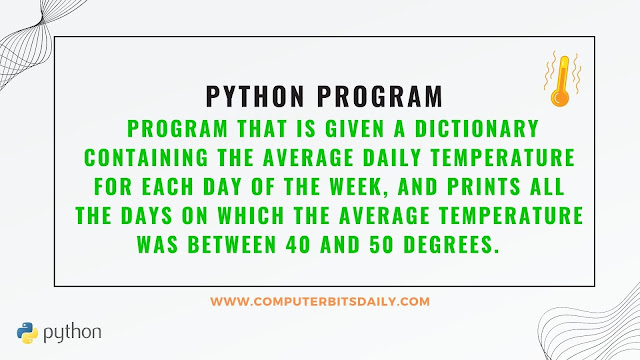Python is a versatile programming language that allows us to perform a wide range of tasks, including data manipulation and analysis. In this blog post, we will explore how to write a Python program that can analyze a dictionary containing the average daily temperature for each day of the week. The program will identify and print all the days on which the average temperature was between 40 and 50 degrees. This can be a useful tool for weather analysis or any other application that involves temperature data.
Table of Contents
- What is Python?
- What is a Dictionary?
- Understanding the Problem
- Writing the Python Program
- Testing the Program
What is Python?
Python is an interpreted, object-oriented, high-level programming language with dynamic semantics.
It is known for its simplicity and readability, making it a popular choice among beginners and experienced programmers alike.
Python offers a wide range of built-in data structures and supports various programming paradigms, including procedural, object-oriented, and functional programming.
Its versatility and ease of use have made it one of the most widely used programming languages in the world.
What is a Dictionary?
A dictionary in Python is a collection that allows us to store data in key-value pairs.
It is similar to a real-world dictionary, where words (keys) are associated with their meanings (values).
The key-value pairs are enclosed in curly brackets {} and separated by commas. Dictionaries are unordered, meaning that the items are not stored in a specific order.
Understanding the Problem
Before we start writing the Python program, let's understand the problem statement.
We are given a dictionary that contains the average daily temperature for each day of the week.
Our task is to identify and print all the days on which the average temperature was between 40 and 50 degrees.
| Practical List - Python [ 4330701 ] [ PRACTICAL EXERCISES ]
Writing the Python Program
To solve this problem, we can iterate through the dictionary and check the average temperature for each day.
If the average temperature falls within the range of 40 to 50 degrees, we will print the corresponding day. Here's the Python program:
# Given dictionary containing average daily temperature
temperature_dict = {
"Monday": 45,
"Tuesday": 50,
"Wednesday": 38,
"Thursday": 42,
"Friday": 48,
"Saturday": 55,
"Sunday": 39
}
# Iterate through the dictionary
for day, temperature in temperature_dict.items():
if 40 <= temperature <= 50:
print(f"The average temperature on {day} was between 40 and 50 degrees.")
| Learn Python with " Computer Courses - All in One "
In this program, we define a dictionary called temperature_dict that contains the average daily temperature for each day of the week. We then iterate through the dictionary using the items() method, which returns a list of key-value pairs. For each day, we check if the average temperature falls within the range of 40 to 50 degrees using a conditional statement. If it does, we print a message indicating that the average temperature was between 40 and 50 degrees on that day.
Testing the Program
To test the program, we can run it with different sets of temperature data. Here's the output for the given temperature_dict:
The average temperature on Monday was between 40 and 50 degrees.
The average temperature on Tuesday was between 40 and 50 degrees.
The average temperature on Thursday was between 40 and 50 degrees.
The average temperature on Friday was between 40 and 50 degrees.
As we can see, the program correctly identifies and prints the days on which the average temperature was between 40 and 50 degrees.
In this blog post, we have explored how to write a Python program that can analyze a dictionary containing the average daily temperature for each day of the week. By iterating through the dictionary and using conditional statements, we were able to identify and print all the days on which the average temperature was between 40 and 50 degrees. Python's simplicity and versatility make it a powerful tool for data analysis and manipulation tasks like this.
Happy coding!
| Practical List - Python [ 4330701 ] [ PRACTICAL EXERCISES ]
FAQs on Python Program to Print Days with Average Temperature between 40 and 50 Degrees
Q1. What is a dictionary in Python?
Q2. What is the problem statement for the Python program?
Q3. How can we write the Python program to solve this problem?
Q4. What are some commonly used dictionary methods in Python?
- pop(): Remove the item with the specified key.
- update(): Add or change dictionary items.
- clear(): Remove all the items from the dictionary.
- keys(): Returns all the dictionary's keys.
- values(): Returns all the dictionary's values.
- get(): Returns the value of the specified key.
- popitem(): Returns the last inserted key and value as a tuple.




0 Comments